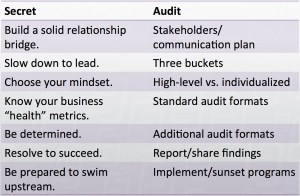
On Thursday, April 28, I had the opportunity to present a webinar on learning portfolio audits as part of the CommPartners Education Innovation Series. I define a learning audit as a systematic review of a learning program or a learning portfolio to determine the strengths and weaknesses with the ultimate aim to guide subsequent improvements. But what does that have to do with thinking like an entrepreneur?
Approximately 27 million working-age Americans are currently starting or running new businesses. What if you could replicate the secrets of their startup success within your own department or organization? Despite the cliché image of entrepreneurs who achieve great things simply flying by the seats of their pants, the most successful businesspeople approach their work with intentionality.
As education providers, we routinely inherit programs with unclear or undefined outcomes; we operate in an increasingly competitive professional development environment with fewer resources and budget-strapped attendees; and we consistently grapple with unrealistic revenue and attendance targets while forgetting to sunset programs past their prime.
My approach to learning audits is designed to help association professionals and industry partners leverage their inner entrepreneurial spirit to categorize, audit and optimize the programs that comprise their learning portfolios, resulting in a stronger brand, an elevated reputation and more loyal participation.
Following are the seven entrepreneurial secrets as originally imagined by Peter Economy in this Inc.com article and my interpretation of how they translate to the learning environment.
Secret 1: Build a solid relationship bridge.
Business is all about relationships, and building strong relationships is a pathway to success in both business and life. Identify key stakeholders (e.g., staff, board, volunteers) who are or who might potentially be affected by learning programs in your organization. Each will likely have a unique perspective/stake in the learning audit. Then, develop, implement and monitor a communication plan that answers the following four questions:

Secret 2: Slow down to lead.
- How will we ensure different silo groups buy into the need and benefit of this project?
- How will we ensure key stakeholders become a part of the process (e.g., taskforce)?
- What is our preferred process/procedure and frequency for check-ins/progress reporting?
- How will we promote/celebrate key milestones?
Business is moving faster than ever, but great leadership means slowing down to take time to focus on doing the things that are most important to your success. Therefore, carefully delineate the three buckets that comprise your learning portfolio before moving forward:
Secret 3: Choose your mindset.
- In-person programs (e.g., annual meetings, multi-day conferences, full/half-day programs);
- Digital/online programs (e.g., podcasts, webinars); and
- Other resources that educate members or have the potential to educate members (e.g., blogs, newsletters, websites, magazines).
You’re the one who decides the path you will take both in life and in business, and you’re the one who can change it. Determine the scope of your learning audit: either big picture or detailed. A big picture audit identifies for each of your three buckets the overall mix (e.g., type of event, number per year, strategic organization alignment, key performance indicators), the trends (e.g., quality of content, speakers, learning and instructional design) and the relationship to your organization’s body of knowledge. Conversely, a detailed audit drills down to measure the attainment of established outcomes for each individual program, and illuminates recommended changes at the program level.

Secret 4: Know your business “health” metrics.
The most successful businesspeople know exactly what makes their organizations tick, and they keep a very close eye on the metrics – making timely corrections when necessary. A typical in-person audit might resemble unbiased third parties observing and taking photos throughout an event; scheduled face-to-face interviews with learners and speakers; or small focus groups or consensus workshops themed around a particular topic. Back at the office, paper audits might include programs assessed against an established rubric; aggregate program evaluations and trend identification; or responses to new survey questions when the necessary data is simply not available. Furthermore, an entire education portfolio might be evaluated to ensure program outcomes align with the organization’s mission, vision and values statements or environmental scanning might be conducted to determine what previously unforeseen member needs might be lurking right around the corner.
Secret 5: Be determined.
Being determined isn’t just having the strength, fortitude and persistence to move forward against the odds, but it’s also being strategically prepared for the battle. In this case, if the standard audit tools and processes aren’t a good match for your organization you might consider these additional audit formats recommended by consultant and researcher Will Thalheimer.
Secret 6: Resolve to succeed.

Know that you can succeed, and then put all of your energy into it. Once we resolve ourselves to achieving something, then nothing can stop us. And it starts with developing a report according to stakeholder needs/wants – either written or verbal (or both). In crafting the report, carefully consider the length/duration, the language used and whether or not to include the raw data/findings.
Secret 7: Be prepared to swim upstream.
No one ever said that finding success in business or in life was going to be easy, and frankly, it’s not. Often you’ll find that you’ve got to swim upstream – against the current – to make great things happen. At this stage it’s time to implement new ideas/recommendations and sunset underperforming/mature programs, products and services. ASAE offers a three-step workbook for selecting and sunsetting association programs, products and services. The steps include building a team, deciding what is important and creating an efficient method.
So what approaches have you found most successful in auditing either a single program or an entire learning portfolio? Please share your thoughts or leave a comment.


